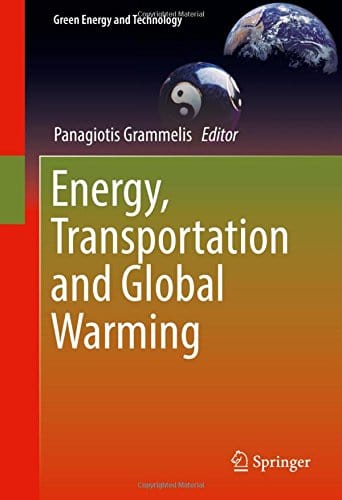
Language: English
Year: June 22, 2016
ISBN-10: 3319301268
Pages: 865
Editors: Grammelis, Panagiotis (Ed.)
Addresses current issues and challenges posed by global warming and climate change
Covers energy-related issues across many engineering disciplines–from renewables to fossil fuels and carbon capture
Addresses the effects and intricacies of air, land and maritime transport–from greenhouse gas emission calculations to assessing the resiliency of multimodal transport networks
This book presents a holistic view of climate change by examining a number of energy and transportation technologies and their impact on the climate. High-quality technical research results from specific test-cases around the globe are presented, and developments in global warming are discussed, focusing on current emissions policies from air and maritime transport to fossil fuel applications. Novel technologies such as carbon capture and storage are investigated together with the corresponding process and systems analysis, as well as optimization for mitigating CO2 emissions. Water resources management, waste water treatment, and waste management issues are also covered. Finally, biomass, hydrogen and solar energy applications are presented along with some insights on green buildings.
Energy, Transportation and Global Warming is of great interest to researchers in the field of renewable and green energy as well as professionals in climate change management, the transportation sector, and environmental policy.
Number of Illustrations and Tables
82 b/w illustrations, 370 illustrations in colour
Topics
Renewable and Green Energy
Climate Change Management and Policy
Transportation
Hydrology / Water Resources
Waste Management / Waste Technology
Environmental Policy

Language: English
Year: May 5, 2016
ISBN-10: 3319311557
Pages: 342
Editors: Papa, Rocco, Fistola, Romano (Eds.)
Examines the energy dimension of the smart city from the perspective of urban planning
Provides a complete overview from theory to practice
Includes contributions from leading Italian researchers in the field
This book examines the energy dimension of the smart city from the perspective of urban planning, providing a complete overview that ranges from theoretical aspects to practical considerations and projects. In addition, it aims to illustrate how the concept of the smart city can enhance understanding of the urban system and foster new forms of management of the metropolis, including with respect to energy supply and use. Specifically, the book explores the different dimensions of the relationship between energy and the city, discusses methodological issues with a special focus on ontological approaches to sustainability, and describes practices, tools, and good examples of energy-related urban planning. The authors represent the main Italian research groups working in the field, Italy being an excellent example of a country exposed to energy problems due to, for example, vulnerability to climate change and lack of primary energy resources. This book will be valuable for students of urban planning, town planners, and researchers interested in understanding the changing nature of the city and the challenges posed by energy issues.
Number of Illustrations and Tables
70 b/w illustrations
Topics
Energy Policy, Economics and Management
Sustainable Development
Urban Geography/Urbanism
Facility Management

Language: English
Year:2016
ISBN: 9535125001 9535124994 9789535124993 9789535125006
Pages: 188
The book reveals the pollution side of this waste stream with critical implications on the environment and public health, and also it points out the resource side which must be further developed under the circular economy framework with respect to safety regulations.
The linkages between developed and developing countries and key issues of e-waste management sector are further examined in the book.
E-waste management is a serious challenge across developed, transition, and developing countries because of the consumer society and the globalization process.
E-waste is a fast-growing waste stream which needs more attention of international organizations, governments, and local authorities in order to improve the current waste management practices.
In this context, complicated patterns at the global scale emerge under legal and illegal e-waste trades.
Contents
Preface
1 E-waste Management as a Global Challenge (Introductory Chapter)
2 Environmental Impact of Processing Electronic Waste – Key Issues and Challenges
3 Regional Distribution and Human Health Effects of Persistent Organic Pollutants (POPs) in Zhejiang Province
4 The Generation, Composition, Collection, Treatment and Disposal System, and Impact of E-Waste
5 Electronic Waste in Mexico – Challenges for Sustainable Management
6 A Review of Technology of Metal Recovery from Electronic Waste
7 Increasing the Use of Secondary Plastics in Electrical and Electronic Equipment and Extending Products Lifetime – Instruments and Concepts

Language: English
Year:2014
ISBN: 0415744113, 0415744121
Pages:200
What is the relationship between design, sustainability, inner values and spirituality? How can we create designs that provide a convincing alternative to unsustainable interpretations of progress, growth, consumerism and commercialism? Building on the arguments first advanced in his widely acclaimed books Sustainable by Design and The Spirit of Design, Stuart Walker explains how we can achieve the systemic changes needed to address the challenges of sustainability.
Challenging common assumptions about the nature of our contemporary material culture and its relationship to human flourishing, the author introduces approaches to design that draw inspiration from nature, summon the human imagination and create outcomes which are environmentally responsible and socially just, as well as meaningful and enriching at a personal level.
Offering a unique and original contribution to this vital debate, Designing Sustainability is destined to become essential reading for students on courses in design and sustainability and for design practitioners looking for a deeper, more meaningful basis for their work.

Year:2013
ISBN: 1609185099\
Pages: 517
Developmental systems theory provides powerful tools for predicting complex, dynamic interactions among biological and environmental processes in human behavior and health. This groundbreaking handbook provides a roadmap for integrating key concepts of developmental systems theory (such as self-organization, reciprocal dynamic interaction, and probabilistic epigenesis) and simulation models (connectionist and agent-based models) with advanced dynamic modeling approaches for testing these theories and models. Internationally renowned developmental science scholars present innovations in research design, measurement, and analysis that offer new means of generating evidence-based decisions to optimize the course of health and positive functioning across the life span. Topics include epigenetic development and evolution; the relationship between neural systems growth and psychological development; the role of family environments in shaping children's cognitive skills and associated adult outcomes, and more.

by Myrna J. Simpson, Andre J. Simpson
Language: English
Year:2014
ISBN: 1118616472
Pages:448
The challenges faced by environmental scientists today are vast, complex, and multi-faceted. For instance, predicting the fate of an environmental pollutant or understanding ecosystem responses to climate change, necessitate a firm understanding of molecular structure and dynamics of environmental media as well as the components that exist and interact within this media. Furthermore, linking information obtained at the molecular-scale to ecosystem-level processes is a major pursuit of modern environmental research. As such, NMR spectroscopy and its scalability from the molecular-scale to the macroscopic-scale, is facilitating rapid growth in environmental science. In addition, the versatility of NMR spectroscopy has resulted in the development and implementation of different types of NMR techniques to examine the structure of various types of environmental samples, living and non-living, as well as the study of critical environmental processes.
This comprehensive handbook is a collection of chapters that span from methods to how NMR is used in environmental research to gain insight into various ecosystem properties.
It is organized into three parts:
Part A focuses on methods used in environmental NMR which span from solution-state to magnetic resonance imaging.
Part B emphasizes how NMR spectroscopy plays an essential role in understanding various types of environmental components and related processes, including different forms of organic matter found in soil, water, and air as well as how NMR is used to probe the fate of water, organic pollutants, and metals in the environment.
Part C focuses on the growing field of environmental metabolomics which uses NMR as its main discovery platform.
This volume highlights the immense potential of NMR spectroscopy to expand our fundamental understanding of environmental processes and how it will continue to do so well into the future.

Year: 2007
ISBN: 1900222248
It thus presents ASM1, ASM2, ASM2d and ASM3 together for the first time. Modelling of activated sludge processes has become a common part of the design and operation of wastewater treatment plants. Today models are being used in design, control, teaching and research.Contents ASM3: Introduction, Comparison of ASM1 and ASM3, ASM3: Definition of compounds in the model, ASM3: Definition of processes in the Model, ASM3: Stoichiometry, ASM3: Kinetics, Limitations of ASM3, Aspects of application of ASM3, ASM3C: A Carbon based model, Conclusion ASM 2d: Introduction, Conceptual Approach, ASM 2d, Typical Wastewater Characteristics and Kinetic and Stoichiometric Constants, Limitations, Conclusion ASM 2: Introduction, ASM 2, Typical Wastewater Characteristics and Kinetic and Stoichiometric Constants, Wastewater Characterization for Activated Sludge Processes, Calibration of the ASM 2, Model Limitations, Conclusion, Bibliography ASM 1: Introduction, Method of Model Presentation, Model Incorporating Carbon Oxidation Nitrification and Denitrification, Characterization of Wastewater and Estimation of Parameter Values, Typical Parameter Ranges, Default Values, and Effects of Environmental Factors, Assumptions, Restrictions and Constraints, Implementation of the Activated Sludge Model

Language: English
Year: 2015
ISBN: 0199362645
Pages: 280
Charles Darwin, the father of the theory of evolution, described the evolutionary origin of flowering plants, which appear to have risen abruptly during the late Cretaceous Period, as an "abominable mystery." The first seed plants appeared in the fossil record some 230 million years earlier, but the transitions leading to the flowering plants left few fossils and remain obscure. The evolutionary history of photosynthetic organisms is full of mysteries great and small, including the origin of photosynthesis itself, the origins of multiple independent lines of algae, the loss of flagella in the red algae, the origin of sporophytes in vascular and non-vascular plants, the early diversification of seed plants, and the origin of the unique monocots.
In Plant Life: A Brief History, botanist Frederick Essig traces how familiar features of plants evolved sequentially over hundreds of millions of years as various environmental challenges and opportunities were met. This chronological narrative begins with the origin of photosynthesis and the rise of cyanobacteria, continues with the evolution and diversification of photosynthetic eukaryotes and their invasion of dry land, explores the varied adaptations for sexual reproduction and dispersal in the terrestrial environment, and concludes with the diverse growth forms of the flowering plants. As different groups of photosynthetic organisms are introduced, the book emphasizes the adaptations that enabled them to gain dominance in existing habitats or move into new habitats. Readers will acquire a deeper understanding of the diverse photosynthetic organisms humans depend upon for food, oxygen, medicine, building materials, and aesthetic pleasure.
With accessible writing and a myriad of figures and illustrations, Essig provides a broad overview of plant evolution that will appeal to students and general audiences alike. Plant Life: A Brief History is a valiant step in the quest to unravel the "abominable mysteries" of plant evolution, and offers a compelling introduction to the exciting and complex world of evolutionary biology.

2010 - 440 Pages -| ISBN: 1604266074 -
Available this summer in its eighth edition, Rosenbaum's classic, comprehensive text once more provides definitive coverage of environmental politics and policy, lively case material, and a balanced assessment of current environmental issues. • A completely revamped energy chapter covering conventional energy policy as well as a comparative examination of alternatives to current energy production. • Expanded discussion of current U.S. climate change policy with attention to the role of the states, the impact of global environmental politics, and emerging technologies on policy alternatives. • Analysis of the Obama administration's energy agenda and its profound differences from Bush administration policies and the practical difficulties of creating an effective political coalition in support of the new policy agenda. • Greater emphasis on executive-congressional relations in the policy-making cycle. • Examination of changes in the environmental movement, with particular attention to newly emerging cleavages over energy and climate issues. • A thorough updating of all policy chapters, including an examination of such topics as "mountain top removal", the emergence of Bisphenol A as an endocrine disruptor issue, and the "new NIMBYism" New and revised tables, figures, and other data illustrate key environmental information while a new, detailed timeline frames the initial chapters historical narrative of evolving environmental policy.
People who voted for this also voted for
More lists from Jorge Van der Loo
 Login
Login




















